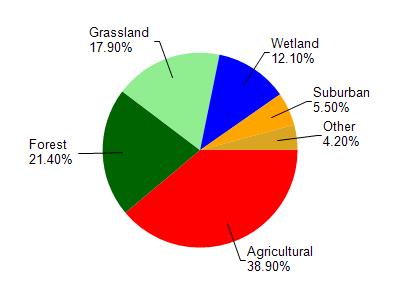Fond Du Lac
No
No
No
Fish and Aquatic Life
Overview
Mullet Lake is a medium sized, hard water, drained lake valued primarily for waterfowl hunting. Its shallow depth and abundance of rooted aquatic plants contribute to annual winterkill conditions which limit the fishery to an occasional northern pike and perch. The outlet stream, the Mullet River, drains north to the Sheboygan River. The shoreline is associated with 350 acres of wetlands, mainly tamarack swamp and cattails. Muskrats and beaver are present. Considerable numbers of ducks use the lake all year and the lake receives heavy hunting pressure during the open season. Six summer cottages are located on the northeast shore, but no public access is available.
Source: 1969, Surface Water Resources of Fond du Lac County Mullet Lake, T15N, R19E, Section 33 Surface Acres = 200.0, S.D.F. = 1.41, Maximum Depth = 7 feet.
Date 1969
Author Aquatic Biologist
Condition
Wisconsin has over 84,000 miles of streams, 15,000 lakes and milllions of acres of wetlands. Assessing the condition of this vast amount of water is challenging. The state's water monitoring program uses a media-based, cross-program approach to analyze water condition. An updated monitoring strategy (2015-2020) is now available. Compliance with Clean Water Act fishable, swimmable standards are located in the Executive Summary of Water Condition in 2018. See also the 'monitoring and projects' tab.
Reports
Recommendations
Natural Areas Protection
Support land acquisitions from willing landowners for the proposed Mullet Lake State Natural Area, so that the area can be designated as a State Natural Area and managed to control invasive species.
Master Planning
Ensure that issues and recommendations from the 2010 Mullet River Watershed Plan are considered during master planning and annual property planning for the Mullet Lake State Natural Area.
Management Goals
Wisconsin's Water Quality Standards provide qualitative and quantitative goals for waters that are protective of Fishable, Swimmable conditions [Learn more]. Waters that do not meet water quality standards are considered impaired and restoration actions are planned and carried out until the water is once again fishable and swimmable
Management goals can include creation or implementation of a Total Maximum Daily Load analysis, a Nine Key Element Plan, or other restoration work, education and outreach and more. If specific recommendations exist for this water, they will be displayed below online.
Monitoring
Monitoring the condition of a river, stream, or lake includes gathering physical, chemical, biological, and habitat data. Comprehensive studies often gather all these parameters in great detail, while lighter assessment events will involve sampling physical, chemical and biological data such as macroinvertebrates. Aquatic macroinvertebrates and fish communities integrate watershed or catchment condition, providing great insight into overall ecosystem health. Chemical and habitat parameters tell researchers more about human induced problems including contaminated runoff, point source dischargers, or habitat issues that foster or limit the potential of aquatic communities to thrive in a given area. Wisconsin's Water Monitoring Strategy was recenty updated.
Grants and Management Projects
| Project Name (Click for Details) | Year Started |
|---|
|
|
Monitoring Projects
| WBIC | Official Waterbody Name | Station ID | Station Name | Earliest Fieldwork Date | Latest Fieldwork Date | View Station | View Data |
|---|
| 56200 | Mullet Lake | 10002485 | Mullet Lake | 7/27/1999 | 9/30/2017 | Map | Data |
|

Watershed Characteristics
Mullet Lake is located in the Mullet River watershed which is 88.19 mi². Land use in the watershed is primarily agricultural (38.90%), forest (21.40%) and a mix of grassland (17.90%) and other uses (21.80%). This watershed has 97.54 stream miles, 789.87 lake acres and 6,609.38 wetland acres.
Nonpoint Source Characteristics
This watershed is ranked High for runoff impacts on streams, Not Ranked for runoff impacts on lakes and High for runoff impacts on groundwater and therefore has an overall rank of High. This value can be used in ranking the watershed or individual waterbodies for grant funding under state and county programs.However, all waters are affected by diffuse pollutant sources regardless of initial water quality. Applications for specific runoff projects under state or county grant programs may be pursued. For more information, go to surface water program grants.